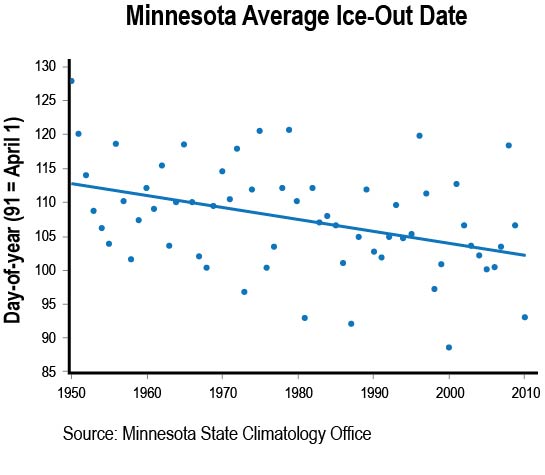Spring is coming, which means the season where we in Minnesota can walk on water will soon end. The date of ice-out (when ice leaves our lakes) is a topic of keen interest all over the upper Midwest. In many local taverns, church basements, and offices, calling the exact date and time of ice-out is a long-standing tradition, elevating one of the ordinary events of our community life.
As our state becomes wetter and warmer, did you know that ice-out dates are changing for Minnesota lakes? Lake ice has gone out in early March for some lakes in southern Minnesota and early June for at least one lake in the far northeastern part of the state (Gunflint Lake).
 Several factors affect the timing of lake ice melting away: the lake itself – depth, shape, geography, and weather or climate conditions – sun angle and intensity, cloud cover, snow cover, air temperature, water temperature, and rainfall. All of these conditions are changing with our increasingly warmer and wetter climate. In particular, winter low temperatures have been increasing across Minnesota and the number of days that lakes are covered by ice has decreased. For example, an average-sized lake in central Minnesota statistically experiences ice-out almost a week sooner than it did in the 1940s. Fishing guides and bait dealers across the state confirm this earlier ice-out phenomenon. The graph at right shows the average ice-out date for lakes from 1950-2010. If you have your trusty 2020 Weatherguide calendar nearby, check out page 12 for a table of ice-out statistics for 20 Minnesota lakes around the state.
Several factors affect the timing of lake ice melting away: the lake itself – depth, shape, geography, and weather or climate conditions – sun angle and intensity, cloud cover, snow cover, air temperature, water temperature, and rainfall. All of these conditions are changing with our increasingly warmer and wetter climate. In particular, winter low temperatures have been increasing across Minnesota and the number of days that lakes are covered by ice has decreased. For example, an average-sized lake in central Minnesota statistically experiences ice-out almost a week sooner than it did in the 1940s. Fishing guides and bait dealers across the state confirm this earlier ice-out phenomenon. The graph at right shows the average ice-out date for lakes from 1950-2010. If you have your trusty 2020 Weatherguide calendar nearby, check out page 12 for a table of ice-out statistics for 20 Minnesota lakes around the state.
Freshwater will again assist in calling the exact time that the ice goes out on Lake Minnetonka here in the western part of the Twin Cities, a task that our founder Dick Gray established decades ago. We love being able to walk on the water during the winter months, but we also love the open water with the arrival of loons. It’s a call to celebrate with our annual celebration of Ice Out, Loon In, an event that raises funds to support the work of Freshwater all year long. Read more about it in this newsletter, or visit us online at freshwater.org.
– John Linc Stine, executive director